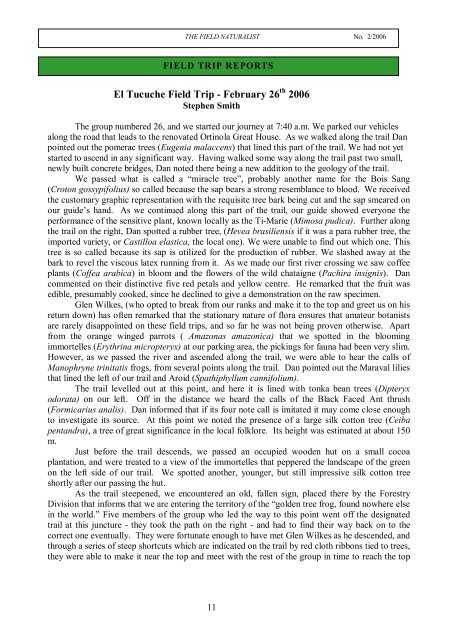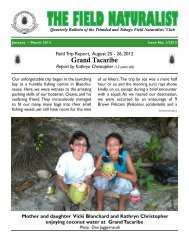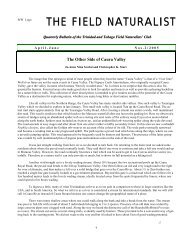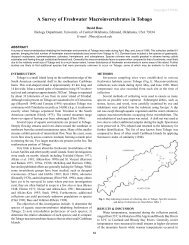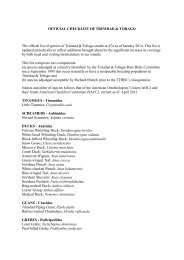Vol 2 - The Trinidad and Tobago Field Naturalists' Club
Vol 2 - The Trinidad and Tobago Field Naturalists' Club
Vol 2 - The Trinidad and Tobago Field Naturalists' Club
You also want an ePaper? Increase the reach of your titles
YUMPU automatically turns print PDFs into web optimized ePapers that Google loves.
THE FIELD NATURALIST No. 2/2006FIELD TRIP REPORTSEl Tucuche <strong>Field</strong> Trip - February 26 th 2006Stephen Smith<strong>The</strong> group numbered 26, <strong>and</strong> we started our journey at 7:40 a.m. We parked our vehiclesalong the road that leads to the renovated Ortinola Great House. As we walked along the trail Danpointed out the pomerac trees (Eugenia malaccens) that lined this part of the trail. We had not yetstarted to ascend in any significant way. Having walked some way along the trail past two small,newly built concrete bridges, Dan noted there being a new addition to the geology of the trail.We passed what is called a “miracle tree”, probably another name for the Bois Sang(Croton gossypifolius) so called because the sap bears a strong resemblance to blood. We receivedthe customary graphic representation with the requisite tree bark being cut <strong>and</strong> the sap smeared onour guide’s h<strong>and</strong>. As we continued along this part of the trail, our guide showed everyone theperformance of the sensitive plant, known locally as the Ti-Marie (Mimosa pudica). Further alongthe trail on the right, Dan spotted a rubber tree, (Hevea brasiliensis if it was a para rubber tree, theimported variety, or Castilloa elastica, the local one). We were unable to find out which one. Thistree is so called because its sap is utilized for the production of rubber. We slashed away at thebark to revel the viscous latex running from it. As we made our first river crossing we saw coffeeplants (Coffea arabica) in bloom <strong>and</strong> the flowers of the wild chataigne (Pachira insignis). Dancommented on their distinctive five red petals <strong>and</strong> yellow centre. He remarked that the fruit wasedible, presumably cooked, since he declined to give a demonstration on the raw specimen.Glen Wilkes, (who opted to break from our ranks <strong>and</strong> make it to the top <strong>and</strong> greet us on hisreturn down) has often remarked that the stationary nature of flora ensures that amateur botanistsare rarely disappointed on these field trips, <strong>and</strong> so far he was not being proven otherwise. Apartfrom the orange winged parrots ( Amazonas amazonica) that we spotted in the bloomingimmortelles (Erythrina micropteryx) at our parking area, the pickings for fauna had been very slim.However, as we passed the river <strong>and</strong> ascended along the trail, we were able to hear the calls ofManophryne trinitatis frogs, from several points along the trail. Dan pointed out the Maraval liliesthat lined the left of our trail <strong>and</strong> Aroid (Spathiphyllum cannifolium).<strong>The</strong> trail levelled out at this point, <strong>and</strong> here it is lined with tonka bean trees (Dipteryxodorata) on our left. Off in the distance we heard the calls of the Black Faced Ant thrush(Formicarius analis). Dan informed that if its four note call is imitated it may come close enoughto investigate its source. At this point we noted the presence of a large silk cotton tree (Ceibapent<strong>and</strong>ra), a tree of great significance in the local folklore. Its height was estimated at about 150m.Just before the trail descends, we passed an occupied wooden hut on a small cocoaplantation, <strong>and</strong> were treated to a view of the immortelles that peppered the l<strong>and</strong>scape of the greenon the left side of our trail. We spotted another, younger, but still impressive silk cotton treeshortly after our passing the hut.As the trail steepened, we encountered an old, fallen sign, placed there by the ForestryDivision that informs that we are entering the territory of the “golden tree frog, found nowhere elsein the world.” Five members of the group who led the way to this point went off the designatedtrail at this juncture - they took the path on the right - <strong>and</strong> had to find their way back on to thecorrect one eventually. <strong>The</strong>y were fortunate enough to have met Glen Wilkes as he descended, <strong>and</strong>through a series of steep shortcuts which are indicated on the trail by red cloth ribbons tied to trees,they were able to make it near the top <strong>and</strong> meet with the rest of the group in time to reach the top11


